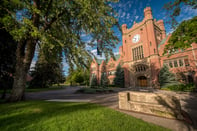Published on
Fostering Connection Between Communities and Institutions

How did we get to this unique moment in higher education? What place will colleges and universities have in the future? Aeronautic-engineer-turned-Buddhist-Master Shinjo Ito said, “Examine the present and learn from the past to see how the future will unfold. Too often we just look at the present and base our actions solely on that.”
Examining the ebbs and flows higher education faces in the United States may help us frame the current issues and prepare for the future. If serving students and maintaining an educated, critically thinking society are worthy goals, our colleges and schools must adapt and be willing to think and act differently. We must recognize and embrace our role as a trusted public good and look to our communities to create meaningful opportunities. Thus, a brief history lesson may help us consider the past as the stepping-stone into today.
Much of our original higher education structure was borrowed from The British Empire, who cared little for the colonists’ academic pursuits. Rather, they favored the lucrative return on investment of the crops produced on the eastern coast’s fertile land. The early settlers looked to organized religion and education as signs of prosperity and civilization in the growing country. Holding fast to English norms, the settlers allowed only white Christians to engage in higher education. Freedom of religion allowed different denominations to flourish alongside and within institutions of higher education. In the early 1800s numerous colleges emerged. Depending solely on tuition and donations, early colleges often struggled from year to year or closed as costs surpassed revenue. Colleges began to diversify the student body by marketing themselves to women willing to pursue common school teaching as an occupation. (Thelin et. al., 2019)
The well-known Morrill Act of 1862 established the federal government as a new and desirable funding source for higher education. States could establish colleges funded by the sale of federal land grants, and the development of these institutions opened higher education to a wider portion of the population. In addition, the Second Morrill Act of 1890—known as the Hatch Act—placed the emphasis on research and additional new student populations.
The period between 1870 and 1890 has been referred to as the Age of the University. Along with expanding the curriculum, extracurricular activities such as fraternities, athletics and fine arts events such as theater productions and art showings made the college atmosphere attractive to donors and prospective students alike. Later, the Serviceman’s Readjustment Act of 1944 opened wide the proverbial doors of colleges and universities to servicemen by offering substantial financial help with tuition, fees and living expenses to those who would attend college. (Thelin et. al., 2019)
The result of expanding programs, extracurricular activities and student scope led to a period of prosperity, as campuses funded largely by federal and state contributions enjoyed growth. However, rapid expansion and a sense of complacency created new problems. Starting around the 1970s, classrooms and dorms experienced overcrowding while personnel, physical development and deferred maintenance costs increased exponentially (Thelin et. al., 2019). Crowded classrooms and plentiful student prospect pools led to overall apathy toward student needs and a growing impersonal approach to student engagement, since it seemed there was a vast student supply should some depart. In addition, new student demographics presented new challenges that academic and student affairs groups were often not equipped to address. Indeed, students who didn’t develop a personal connection to their campus or struggled with academic or personal challenges were often the first to leave. During the 2008 economic crisis, birth rates in the United States decreased sharply, and colleges have since had the opportunity to prepare for what’s been labeled the enrollment cliff. However, many colleges didn’t address the looming crisis and could not have anticipated the volume of increased competition combined with a global pandemic and a shift in public perception toward higher education that would converge in conjunction with the cliff.
In 2009, 70% of high school graduates went directly into higher education programs because parents and students alike understood that a college degree would allow individuals to earn more money than those with only a high school education. Today, only 41% of students consider postsecondary education very important. Emphasis on career and technical education combined with post-COVID employment opportunities encourage graduating high school students to promptly enter the workforce, delaying or bypassing higher education. And while it holds true that individuals with a bachelor’s degree still earn roughly two thirds more than high school graduates, the ability to build wealth has declined dramatically (Tough, 2023).
The rising cost of tuition, coupled with dismal student retention numbers means that many students will graduate with significant debt. Depending on their academic pursuits, graduates may also be significantly delayed in taking wealth-building steps such as home ownership or investing in retirement while they pay back student loans. Even worse are the students who depart college without a degree, since they take on college debt without the advantage of a credential, and their prospects for building wealth become improbable. Students and their parents often feel threatened knowing that college may be challenging and the prospects of dropping out could lead to negative, irreversible financial consequences. Add to this a political climate where liberalism is perceived as an undesirable outcome of a college education, where social activism and patriotism present themselves as divergent ideas, and it is easy to see that higher education faces a unique set of vexing challenges.
With our history lesson in the rearview, we can look to our peer colleges doing exemplary work in their communities and beyond to restore faith in higher education as a social mobility tool and economic driver. Colleges, especially those that serve at brick-and-mortar institutions, should be compelled to look to their communities and engage in meaningful dialogue to first understand and then be a partner in solving the challenges their neighbors face.
There are numerous examples of colleges taking active roles in community engagement to address needs such as infrastructure, food insecurity, broadband access and talent development as well as those delving into commercial real estate development, collaborative research and historical preservation to demonstrate their relevance in the community. (Fischer, 2023)
As higher education professionals, we all sit in a place of influence on our campuses. Although our work is often listed as discrete bullet points on a job description, the true nature of our work is to be co-creators and innovators within our areas of influence. The acts of continually learning, evolving and changing require conversation, collaboration and creativity. Openness to the changing dynamics on our campuses and within our communities demands that we spend our time with and in the community, listening for understanding and working in our areas of influence to blend and braid solutions that uplift the institution and the community together.
References
Fischer, K. (2023). College as a Public Good.
Thelin, J., Edwards, J. & Moyen, E. (2019). Higher Education in the United States - HISTORICAL DEVELOPMENT, SYSTEM. Stateuniversity.com. https://education.stateuniversity.com/pages/2044/Higher-Education-in-United-States.html.
Tough, Paul. “Americans Are Losing Faith in the Value of College. Whose Fault Is That?” The New York Times, 5 Sept. 2023, www.nytimes.com/2023/09/05/magazine/college-worth-price.html. Accessed 10 Oct. 2023.



